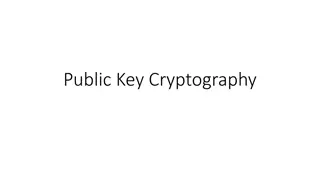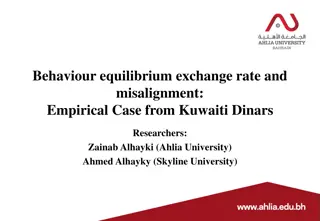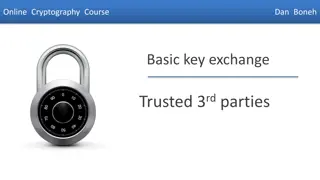Understanding Diffie-Hellman Key Exchange Algorithm
The Diffie-Hellman key exchange algorithm, a pioneering public-key cryptography method introduced by Diffie and Hellman in 1976, enables secure key exchange between two users to facilitate subsequent message encryption. The algorithm relies on the complexity of computing discrete logarithms and involves the use of primitive roots of prime numbers. This process involves each user selecting private and public keys, which are then used to compute a shared key for secure communication.
Download Presentation

Please find below an Image/Link to download the presentation.
The content on the website is provided AS IS for your information and personal use only. It may not be sold, licensed, or shared on other websites without obtaining consent from the author. Download presentation by click this link. If you encounter any issues during the download, it is possible that the publisher has removed the file from their server.
E N D
Presentation Transcript
Diffie-Hellman Key Exchange Man-in-the-Middle Attack Elgamal Cryptographic System
Diffie-Hellman Key Exchange
The first published public-key algorithm appeared in the seminal paper by Diffie and Hellman that defined public- key cryptography [1976] and is generally referred to as Diffie-Hellman key exchange. A number of commercial products employ this key exchange technique. The purpose of the algorithm is to enable two users to securely exchange a key that can then be used for subsequent symmetric encryption of messages. The algorithm is limited to the exchange of secret values.
The Diffie-Hellman algorithm depends for its effectiveness on the difficulty of computing discrete logarithms. Briefly, we can define the discrete logarithm in the following way: a primitive root of a prime number p is one whose powers modulo p generate all the integers from 1 to p - 1. That is, if a is a primitive root of the prime number p, then the numbers a mod p, a2mod p, , ap-1mod p are distinct and consist of the integers from 1 through p - 1 in some permutation.
Example: Powers of Integers, Modulo 19 For the prime number 19, its primitive roots are 2, 3, 10, 13, 14, and 15.
For any integer b and a primitive root a of prime number p, we can find a unique exponent i such that: b ai(mod p), where 0 i (p - 1) The exponent i is referred to as the discrete logarithm of b for the base a, mod p. We express this value as dloga,p(b) = i. Example: dlog2,19(1) = 18 218mod 19 = 262144 mod 19 = 1
The Algorithm of Diffie-Hellman key exchange There are two publicly known numbers: a prime number q and an integer that is a primitive root of q. Suppose the usersAand B wish to create a shared key. UserAselects a random integer XA< q and computes: YA= ^XAmod q. Similarly, user B independently selects a random integer XB < q and computes YB= ^XBmod q.
Each side keeps the X value private and makes the Y value available publicly to the other side. Thus, XAis A s private key and YAis A s corresponding public key, similarly for B. User A computes the key as K = (YB)^XAmod q and user B computes the key as K = (YA)^XBmod q.
User A computes the key as: and user B computes the key as: K = (YB)^XAmod q K = (YA)^XBmod q. The result is that the two sides have exchanged a secret value. Typically, this secret value is used as shared symmetric secret key.
For an adversary who wishes to determine the secret key K. Because XAand XBare private, an adversary only has the following ingredients to work with: q, , YA, and YB. Thus, the adversary is forced to take a discrete logarithm to determine the key. For example, to determine the private key of user B, an adversary must compute XB= dlog ,q(YB) The adversary can then calculate the key K in the same manner as user B calculates it. That is, the adversary can calculate K as K = (YA)^XB mod q The security of the Diffie-Hellman key exchange lies in the fact that, while it is relatively easy to calculate exponentials modulo a prime, it is very difficult to calculate discrete logarithms. For large primes, the latter task is considered infeasible.
Example: Key exchange is based on the use of the prime number q = 353 and a primitive root of 353, in this case = 3. A and B select private keys XA= 97 and XB= 233, respectively. A computes its public key : YA= 397mod 353 = 40. B computes its public key: YB= 3233mod 353 = 248. A computes K = (YB)^XAmod 353 = 24897mod 353 = 160. B computes K = (YA)^XBmod 353 = 40233mod 353 = 160.
We assume an attacker would have available the following information: q = 353; = 3; YA= 40; YB= 248 In this simple example, it would be possible by brute force to determine the secret key 160. In particular, an attacker E can determine the common key by discovering a solution to the equation: 3amod 353 = 40 or the equation 3bmod 353 = 248. The brute-force approach is to calculate powers of 3 modulo 353, stopping when the result equals either 40 or 248. The desired answer is reached with the exponent value of 97, which provides 397mod 353 = 40. With larger numbers, the problem becomes impractical.
Man-in-the-Middle Attack Suppose Alice and Bob wish to exchange keys, and Darth is the adversary. The attack proceeds as follows
At this point, Bob and Alice think that they share a secret key, but instead Bob and Darth share secret key K1 and Alice and Darth share secret key K2. All future communication between Bob and Alice is compromised in the following way. 1. Alice sends an encrypted message M: E(K2, M). 2. Darth intercepts the encrypted message and decrypts it to recover M. 3. Darth sends Bob E(K1, M) or E(K1, M ), where M is any message. In the first case, Darth simply wants to eavesdrop on the communication without altering it. In the second case, Darth wants to modify the message going to Bob.
The key exchange protocol is insecure against a man-in- the-middle attack and vulnerable to such an attack because it does not authenticate the participants. This vulnerability can be overcome with the use of digital signatures and public-key certificates; these topics are explored later.
Elgamal Cryptographic System In 1984, T. Elgamal announced a public-key scheme based on discrete logarithms, closely related to the Diffie-Hellman technique. The Elgamal cryptosystem is used in some form in a number of standards including the digital signature standard (DSS), and the S/MIME e-mail standard. As with Diffie-Hellman, the global elements of Elgamal are a prime number q and , which is a primitive root of q.
User Agenerates a private/public key pair as follows: 1. Generate a random integer XA, such that 1 < XA< q - 1. 2. Compute YA= ^XAmod q. 3. A s private key is XAand A s public key is {q, , YA}. User B that has access to A s public key can encrypt a message as: 1. Represent the message as an integer M in the range 0 < M < q - 1. Longer messages are sent as a sequence of blocks, with each block being an integer less than q. 2. Choose a random integer k such that 1 k q - 1. 3. Compute a one-time key K = (YA)kmod q. 4. Encrypt M as the pair of integers (C1, C2) where C1= kmod q; C2= KM mod q
User Arecovers the plaintext as follows: 1. Recover the key by computing K = (C1)^XAmod q. 2. Compute M = (C2K-1) mod q. In these steps : Alice generates a public/private key pair; Bob encrypts usingAlice s public key; Alice decrypts using her private key. Let us demonstrate why the Elgamal scheme works. =
K functions as a one-time key, used to encrypt and decrypt the message.
Example: let q = 19. It has primitive roots {2, 3, 10, 13, 14, 15}. We choose = 10. Alice generates a key pair as follows: 1. Alice chooses XA= 5. 2. Then YA= ^XAmod q = 5mod 19 = 3. 3. Alice s private key is 5 and Alice s public key is {q, , YA}= {19, 10, 3}. Suppose Bob wants to send the message with the value M = 17. Then: 1. Bob chooses k = 6. 2. Then K = (YA) k mod q = 36mod 19 = 729 mod 19 = 7. 3. So C1= kmod q = 6mod 19 = 11 C2= KM mod q = 7 * 17 mod 19 = 119 mod 19 = 5 4. Bob sends the ciphertext (11, 5). For decryption: 1. Alice calculates K=(C1)^XAmod q = 115mod 19 = 161051 mod 19=7 2. Then K-1is 7-1mod 19 = 11 K-1=(1+n*19)/7 (take the integer result) 3. Finally, M = (C2K-1) mod q = 5 * 11 mod 19 = 55 mod 19 = 17.
If a message must be broken up into blocks and sent as a sequence of encrypted blocks, a unique value of k should be used for each block. If k is used for more than one block, knowledge of one block M1 of the message enables the user to compute other blocks as follows, Let C1,1= kmod q; C2,1= KM1mod q C1,2= kmod q; C2,2= KM2mod q Then, C2,1/ C2,2= (KM1mod q) / KM2mod q = M1mod q / M2mod q If M1is known, then M2is easily computed as M2= (C2,1)-1C2,2M1mod q The security of Elgamal is based on the difficulty of computing discrete logarithms.
To recover As private key, an adversary would have to compute XA= dloga,q(YA). Alternatively, to recover the one-time key K, an adversary would have to determine the random number k, and this would require computing the discrete logarithm k = dloga,q(C1). It is points out that these calculations are regarded as infeasible if p is at least 300 decimal digits and q - 1 has at least one large prime factor.























